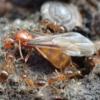Hello everyone,
Earlier today, my brother and I went out in search for Lasius and Brachymyrmex depilis queens. The conditions were perfect: it wasn't too hot or too cold, it had rained for two days (through yesterday morning), it was relatively dry outside (but not too dry), and it was Labor Day! We strolled up and down our long driveway, inspecting the nest entrances of several L. neoniger colonies to find workers failing to pull reluctant alates out of their nests. We searched for about half an hour more with no luck, hypothesizing about the surprising lack of activity.
We took a small break and sat down between two Lasius mounds, and at the same location where witnessed a B. depilis flight a year ago. I knew for a fact Brachymyrmex were flying; I had seen several male alates earlier. I noticed a small winged insect glowing in the sun flying at about knee-height and watched it slowly plummet to the ground. I figured it was a Brachymyrmex male; it was every small. I looked closer, and watched as the mysterious insect detached its wings in an identical matter a Lasius queen would, and continued the unmistakable ritual of looking for a prime spot to dig a founding chamber.
I licked my finger and gently dabbed the queen to collect it. I'm afraid I may have injured it at this point; I placed it in a glass vial and it immediately flipped over. Nevertheless, I put it in a very small test tube setup after its photoshoot. I don't expect it to survive very long; it seems to be missing two legs as well (also my fault). Once it passes, I'll store it in some ethanol and take some better pictures.
I took some photos of the ant through the lens of a handheld microscope, they're not great but they may help.
I would suggest clicking on the photos and zooming in using your mouse to really make the most of the images.
1. Location (on a map) of collection: Ambler, Pennsylvania.
2. Date of collection: September 4th, 2017.
3. Habitat of collection: Deciduous forest surrounding a field
4. Length (from head to gaster): .90-1.10 mm.
5. Color, hue, pattern and texture: Light brown with a greyish gaster in the shade, translucent golden-yellow under light.
6. Distinguishing characteristics: Head looks considerably large relative to its body size; gaster relatively small relative to body size. One petiole node, very close to gaster.
7. Distinguishing behavior: NA
8. Nest description: NA


















Edited by VoidElecent, September 4 2017 - 3:47 PM.

















